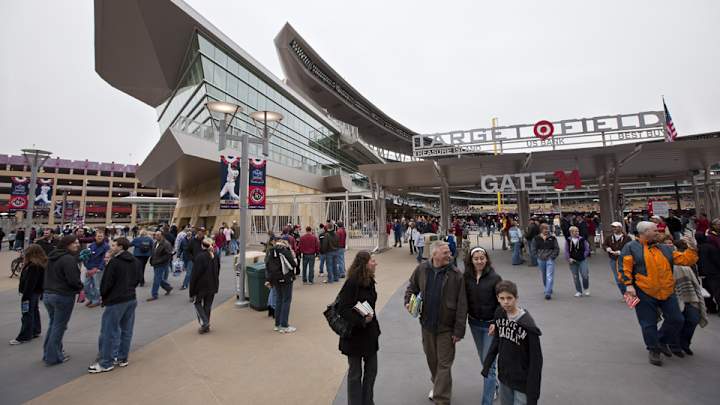Ballpark Quirks: Minnesota's Target Field unveils its All-Star plaza

For the 2014 All-Star Game, the Minnesota Twins wanted to make fans feel welcome and also show off a signature element of Target Field. After all, this year's Midsummer Classic is the first for the park, which was opened in 2010, and the first for Minneapolis since 1985. So to put its best foot forward, Minnesota decided to emphasize the park's immediate connection to the outside world: Target Plaza.
Located near leftfield directly behind Gate 34—the gate is so-numbered in Kirby Puckett’s honor—the plaza quite literally connects the light rail station, cleverly named Target Field Station, to the stadium. But the plaza functions as more than just a gathering place or a way for fans to get from public transit to their seats. As Populous architect Earl Santee explained, the area functions as a way to expand Target Field into its surrounding area and connect the stadium to its city.
“We wanted the street to come into the plaza and project itself into the field,” Santee said. “When the gates are open, you can wander in and have a viewing platform to see Target Field, all of it.”
Initially called "the overlook," the plaza had to be built essentially from scratch. “Basically, we didn’t have any streets, so we didn’t have any sidewalks,” Santee said. “So we had to build the thing.”
While the plaza itself rests outside the stadium, Santee said that it works as a piece of Target Field, giving riders of light rail an immediate connection to the stadium and an unusual aspect.
There also echoes of Minnesota's baseball past in Target Plaza. When the Twins unveiled the 39,000-seat Target Field after spending 28 years in the Metrodome, the team included some key features from their old home in the ledge and plaza. There, you can find baseball-bat frames lit up in changing light patterns; multiple statues of former players, such as Kirby Puckett, Rod Carew, Kent Hrbek and Harmon Killebrew; an ode to past Twins’ ballparks; and a large golden glove statue that has become a popular photo opportunity for fans.
The plaza isn’t just a baseball stadium extension, though. There's also green space, a 1,000-seat amphitheater, office space, retail shops and an underground parking garage that features a color-shifting wall.
The entire plaza was wrapped with native limestone from nearby Kasota. “We were proud of it,” Santee said, “so we put native limestone around it to give it imagery. It is a powerful moment for the design team to connect the ballpark to the city.”
Come All-Star weekend, the Twins will be ready to show off their new home, and the overlook and plaza will help connect it all.
Tim Newcomb covers stadiums, design and gear for Sports Illustrated. Follow him on Twitter at @tdnewcomb.
